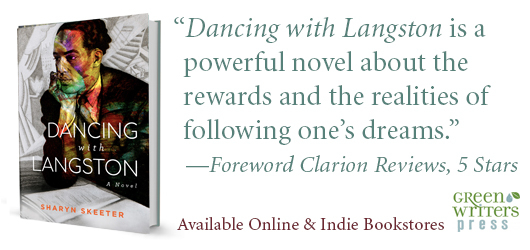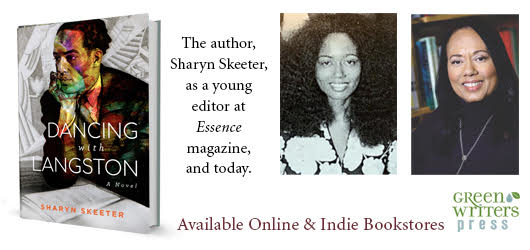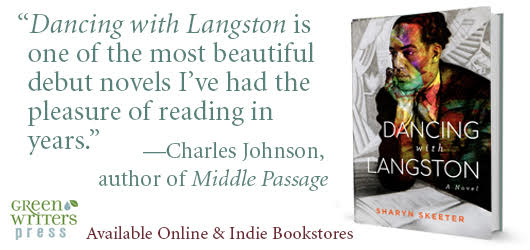An Interview with Sharyn Skeeter, Author of Dancing with Langston
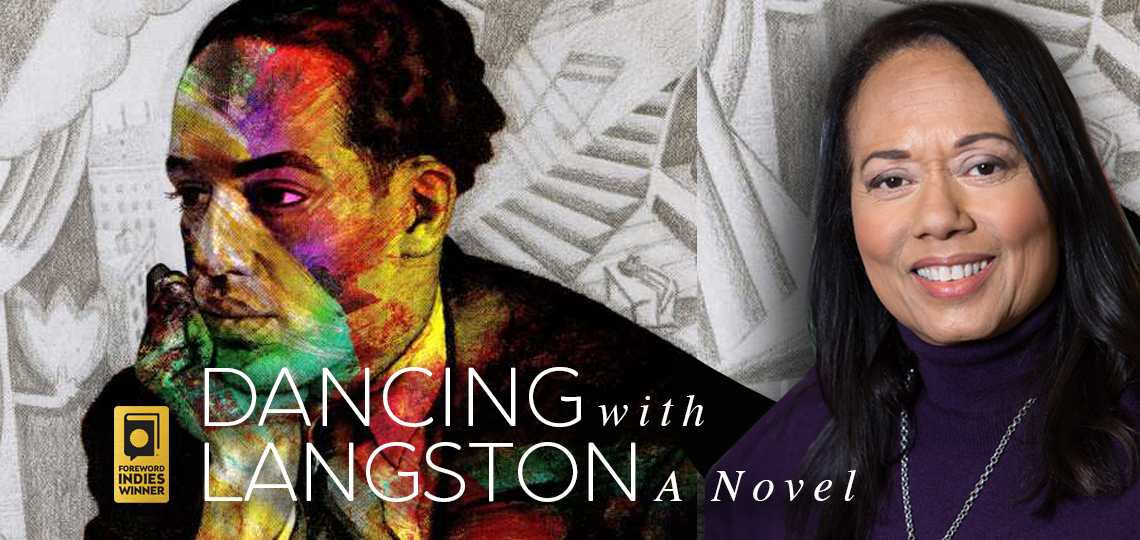
Many of us started out this period of self-isolation with high hopes and big dreams. We were finally going to make a dent in that to-read list, plant that garden, clear out the garage, or—apparently for a great many of us—learn to bake bread. We had hoped, perhaps even expected of ourselves, for this to be a period of personal renaissance. What most of us found, however, were minds too dampened by anxiety and grief to get creativity to spark. Our limited energy went into the struggle of adopting new routines and adapting to new stressors, and our lofty goals became exercises in “good enough.”
While a global pandemic is not the most logical time to be heightening expectations for ourselves, we live in a society that measures worth in productivity, and have been conditioned to feel guilty for accepting “good enough” rather than perpetually striving for perfection. From our families to our cultures to our own inner demons, we are given pictures of what “success” means, and encouraged to scrabble after it at all costs—including our own happiness. Even knowing that this ideology is a slow-but-sure path to burnout and despondence, it can be difficult to step off the ascribed path to success and forge our own.
This question of the life not lived is examined in-depth by Sharyn Skeeter in her debut novel, Dancing with Langston. Carrie’s perfect-on-paper life is upended in a single day when she pays a visit to her late father’s cousin Ella, whom she has promised to help move into an assisted living facility. Through Ella’s stories about their family history—inspired by true stories passed down to Sharyn through her family—Carrie finds the courage to ask whether she is truly happy, or simply just content.
Eileen Gonzalez called Dancing with Langston “a powerful novel about the rewards and the realities of following one’s dreams” in her five-star Clarion review, and, with the title also earning gold in multicultural fiction in the 2019 Foreword INDIES Awards, we reached out to Sharyn to connect her with Eileen for an interview on this captivating novel.
Over to you, Eileen!
Dancing with Langston was inspired by your own family’s stories about Langston Hughes. How much of what made it into the book is what you grew up hearing, and how much did you add or embellish for the sake of the story?
My father’s mother was a Langston. I had heard that when he was in New York City, Langston Hughes had visited her sister’s family who lived on Sugar Hill in Harlem. Also, I grew up hearing my father’s stories as a black Army sergeant in Europe during World War II. But I never got to meet Langston and I’m not sure if my father did.
So, Dancing with Langston is fiction. When I imagined the story, I wondered what it might have been like if Langston and my father had met. I sometimes call it “biofiction” because I did modify some of my father’s war experiences to highlight aspects of Doyle’s character.
But, clearly, it was not my intention to write a family tale. I wrote Dancing with Langston as a novel—a work of fiction—to have the freedom to explore other ideas.
Most of the action takes place in one small apartment, yet the story is gripping from start to finish. Was it a challenge to create a compelling, even suspenseful narrative within the confines of a single location?
No, it wasn’t a challenge at all. I lived in New York City apartments as a child and young adult. Many of my friends and relatives are also New Yorkers. So, a New York apartment, containing its own secrets and stories, wasn’t at all hard to imagine.
What was difficult imagining was how an elderly couple could be in such a small, cluttered apartment for years without going out. Before they lived in that location and especially during their heyday in Paris, both Cousin Ella and Jack had been active, assertive people.
In Harlem, they did manage to create a social life for themselves that supported their artistic inclinations and brought them basic benefits like groceries. Even in her nineties, Cousin Ella is still energetic and mentally alert. But over the years, they became emotionally stuck in their own cluttered and complicated histories. The narrative deals with why.
There are so many wonderful, memorable characters, both in the present day and in Cousin Ella’s past. Do you have any favorites? Was anyone’s personality more difficult to nail down than the others?
That’s hard to answer because I love all the characters. Bill was difficult because he really is doing well in his work. He thinks his view of success is right not only for him but also for Carrie, partly because she never had the courage to tell him about her own interests. The tension that creates between them was a challenge for me.
But perhaps Cousin Ella edges out the others as a favorite because she brings all of them together. She’s the reason for Carrie’s visit. In her own way, she shows compassion and love for others, even toward her brief acquaintance Felix, the construction worker. Though she has her own issues to work out, among these characters, she is the elder, wise woman.
This is your first novel, but you’ve been a writer for years. How did your experience writing Dancing with Langston differ from your previous writing experiences?
Previously, I’d been a magazine editor—fiction/poetry/book review editor at Essence and editor in chief at Black Elegance. While at those magazines, I wrote short articles. Then and when I taught at colleges and universities in the Northeast, my poetry and other pieces were published elsewhere.
A definite difference from those writings and Dancing with Langston was the time and effort it took to finish the novel. Yes, I had written shorter pieces. But I was not used to sitting at my desk, researching, revising, even at times staring at the blank screen for long periods to finish the novel. But once I got the first draft done, I enjoyed working on revisions. That’s when I really watched the novel take shape.
I’m quite humbled that this enjoyable writing experience has led to this year’s Gold Foreword Reviews INDIES Book of the Year Award (multicultural adult fiction).
Dancing with Langston spans the glory days of the Harlem Renaissance in Paris and New York City to the 2000s. How does it relate to the difficult times we’re having now?
The novel’s setting is an apartment that is to be remodeled for gentrification in a traditionally Black neighborhood in Harlem. So, Cousin Ella and Jack have to leave, taking with them fading memories of their own and the community’s rich history.
They, as many of us, are fearful of and resistant to necessary change. The process of moving brings to the surface their habitual pain and repressed love that they’ve buried in years of emotional and physical clutter. It’s a habit that’s hard to break.
As the old couple, we’re all living in a transition that’s pushing us to sort through our long-held ideas, relationships, and material goods so we can free ourselves to confront the issues at hand. If these characters don’t accept this challenge, they will be stuck in their condemned comfort zone until the inevitable conditions force them out. In the novel, it’s up to Carrie to curate the old belongings and stories to create a narrative that works for the present.
The book seems to have multiple messages that readers can take away from it, most notably how important—and how difficult—it is to follow your own path in life. What do you hope readers get out of this book?
As I mentioned, I’d wondered what would happen if my father (a family man) and Langston Hughes (a renowned and prolific writer) had met. They were both intelligent and talented, but chose very different paths. I wanted to find a middle place where they could meet and respect each other.
This is a challenge that many artists—writers, visual artists, actors, dancers, musicians, and others—encounter within themselves as they try to do their art. But this dilemma can be felt by anyone when you’re torn between doing what you love and paying your rent. It can be especially daunting for Black and other artists of color. In Dancing with Langston, Carrie, with help from others, discovers a middle way to resolve this.
My hope is that anyone struggling with this problem, at any level, would find a productive and fulfilling way to live. But part of that struggle is learning to love yourself and others, even when getting through to that love is painful and overwhelming. All of the characters in the novel have to do this.
Dancing with Langston
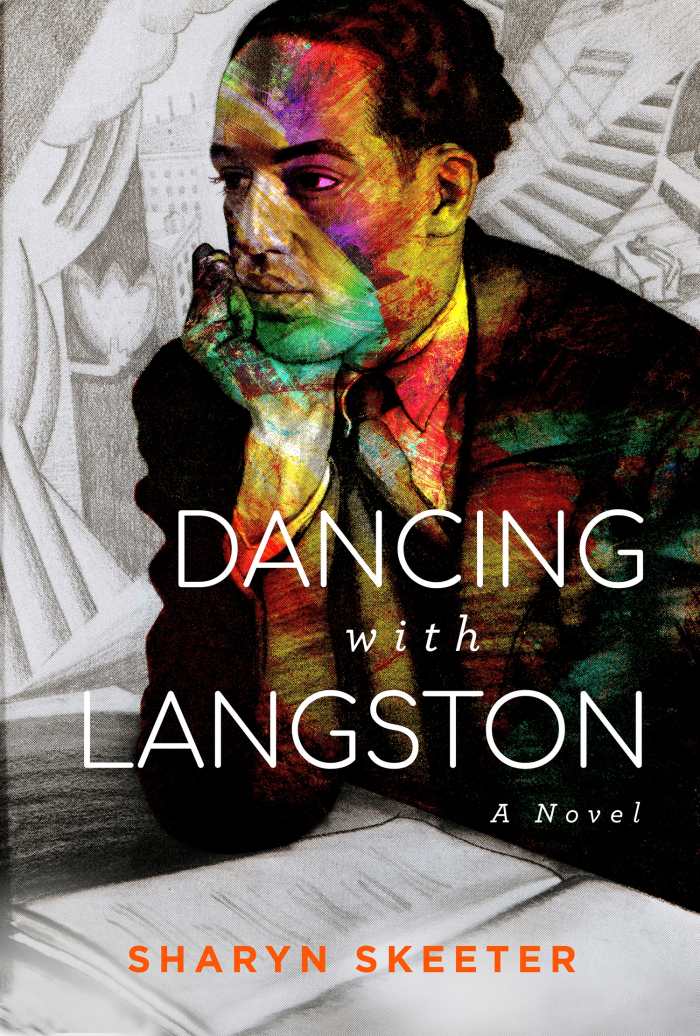
Sharyn Skeeter
Green Writers Press
Softcover $19.95 (206pp)
978-1-950584-19-2
Buy: Local Bookstore (Bookshop), Amazon
Dancing with Langston is a powerful novel about the rewards and the realities of following one’s dreams.
A visit to an elderly relative turns a mourning woman’s life upside down in Sharyn Skeeter’s absorbing novel Dancing with Langston.
Before she can move out west and start a new life, Carrie must fulfill one last promise to her late father: to help his cousin Ella settle into an assisted living facility. What Carrie expects to be a quick and simple task soon turns into a painful journey into Ella and Carrie’s pasts. The more Carrie learns about her vivacious family history and her secretive father, the more she wonders if her own dependable life is truly the one she wants.
The story takes place over the course of a single day and is mostly set in Ella’s cluttered, condemned apartment. It is a fascinating place, steeped in history and tragedy. Sights, scents, and textures combine to form an immersive world that keeps its occupants suspended in the past while propelling Carrie to a brighter future.
Ella’s life is just as gripping, and she shares it with Carrie slowly, revealing old family tales featuring luminaries including Zora Neale Hurston and Langston Hughes. While entertaining in their own right, of greater interest are the lessons that these stories, and the faded treasures hidden in the apartment, can teach—a fact that Carrie comes to realize the longer she allows herself to listen to Ella’s words.
The direct plot and single setting allow the heartbreaking, resilient characters to shine. Every character has more going on than is stated in explicit terms, and there’s nuance and depth to their interactions. Relationships are depicted in subtle but evocative ways, as with Carrie’s husband, for whom one conversation makes it clear what sort of man he is and what his marriage is like. From Ella’s different ways of answering the door to the neighbors’ clothing, the details are sharp.
Carrie’s day of self-discovery culminates in a moving finale. Her life is no easier than it was before—if anything, it’s harder. But knowing that she has grown enough to choose the more difficult and more rewarding path is cathartic. Thought-provoking discussion questions cap the work with sensitivity.
Its details exquisite and its characters compelling, Dancing with Langston is a powerful novel about the rewards and the realities of following one’s dreams.
EILEEN GONZALEZ (February 12, 2020)
Eileen Gonzalez

